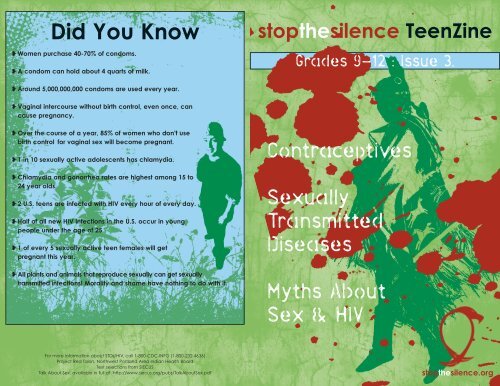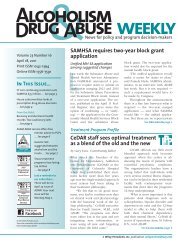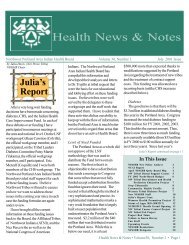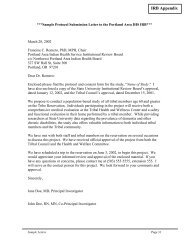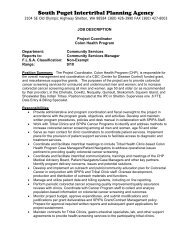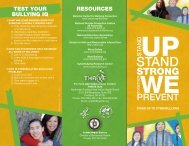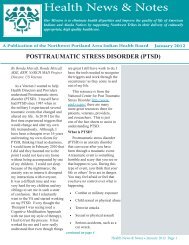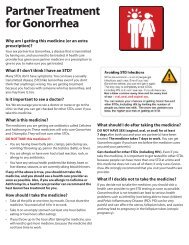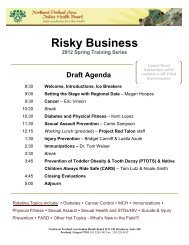Did You Know - Northwest Portland Area Indian Health Board
Did You Know - Northwest Portland Area Indian Health Board
Did You Know - Northwest Portland Area Indian Health Board
- No tags were found...
Create successful ePaper yourself
Turn your PDF publications into a flip-book with our unique Google optimized e-Paper software.
<strong>Did</strong> <strong>You</strong> <strong>Know</strong>❥ Women purchase 40-70% of condoms.❥ A condom can hold about 4 quarts of milk.stopthesilence TeenZineGrades 9-12 : Issue 3.❥ Around 5,000,000,000 condoms are used every year.❥ Vaginal intercourse without birth control, even once, cancause pregnancy.❥ Over the course of a year, 85% of women who don't usebirth control for vaginal sex will become pregnant.❥ 1 in 10 sexually active adolescents has chlamydia.❥ Chlamydia and gonorrhea rates are highest among 15 to24 year olds.❥ 2 U.S. teens are infected with HIV every hour of every day.❥ Half of all new HIV infections in the U.S. occur in youngpeople under the age of 25.❥ 1 of every 5 sexually active teen females will getpregnant this year.❥ All plants and animals that reproduce sexually can get sexuallytransmitted infections! Morality and shame have nothing to do with it.ContraceptivesSexuallyTransmittedDiseasesMyths AboutSex & HIVFor more information about STDs/HIV, call 1-800-CDC-INFO (1-800-232-4636)Project Red Talon, <strong>Northwest</strong> <strong>Portland</strong> <strong>Area</strong> <strong>Indian</strong> <strong>Health</strong> <strong>Board</strong>Text selections from SIECUSTalk About Sex, available in full at: http://www.siecus.org/pubs/TalkAboutSex.pdfstopthesilence.org
Risk ReductionThe surest way to avoid pregnancy and sexually transmitteddiseases is to abstain from sexual activities. Couples can alsodecide to reduce their risk through safer-sex practices. “Safersex” is anything done to lower your risk for pregnancy or STDs.Risk Reduction StrategiesCondoms - Condoms block the exchange of body fluids and protectyou and your partner during vaginal, anal, and oral sex. In order forcondoms to be effective, they must be used with every partner, everytime you have sex.Latex - Latex condoms are the most effective way for people whohave vaginal and anal intercourse to reduce the risk of HIV and otherSTDs. Latex condoms are up to 98% effective against pregnancywhen used correctly.Polyurethane - Compared to latex condoms, polyurethane condomsare less elastic and looser-fitting, making them slightly more likely tobreak or slip off.Animal Skin Condoms - Animal skin condoms are not as effective aslatex or polyurethane condoms in preventing viral infections like HIV.Female condoms - Female condoms reduce the risk of both unwantedpregnancy (95% effective) and STDs, when used consistently andcorrectly. In fact, female condoms may provide increased protectionagainst infections that can be spread through skin-to-skin contact.Lubricated - Some condoms come with a thin layer of lubricationalready on them. Lubricated condoms are best for vaginal and analintercourse — they feel better and are less likely to break from friction.Nonoxynol-9 - Some lubricated condoms contain Nonoxynol-9. Thisspermicide can reduce the risk of pregnancy, but may cause irritationthat can increase the risk of getting an STD.Unlubricated - If you use unlubricated latex condoms, it's a goodidea to add a water-based lubricant, like K-Y jelly or Astroglide, toreduce the risk of breakage. Oil-based lubricants, like body lotion orVaseline, can damage latex.Oral Dams - Dental dams are sheets of latex used for oral-anal ororal-vaginal sex. They protect against STDs and HIV that may betransmitted by vaginal fluids or anal contact and are an option forcleaner sex. Non-microwavable saran wrap, cut condoms, and cutlatex gloves can be used too!Pregnacy PreventionPeople who decide to have vaginal intercourse but don't want tocause pregnancy use birth control. There are many kinds of birthcontrol, including:Hormonal methods. These protect from unintended pregnancy, but donot protect against STDs! They work by preventing the egg from beingfertilized.Pills- contain hormones and are taken daily on a monthly schedule.Like other medicines, prescription birth control may have sideeffects and health risks for some women.2 3Rings- sit in the vagina and can be worn for three weeks at a timeand then take it out for a week. <strong>You</strong> put a new one in every month.Patches- worn on the skin for a week at a time on the buttocks,stomach, outer arm, or upper torso. <strong>You</strong> wear it for three weeks andthen leave it off for a week.Injections, like “Depo”- are a hormonal shot you get every threemonths (usually in your arm).IUD- an Intrauterine Device (IUD) is a small object that is insertedthrough the cervix and placed in the uterus. IUDs can last 1-10 years.They affect the movements of eggs and sperm to preventfertilization and change the lining of the uterus to prevent implantation.IUDs are 99.2-99.9% effective as birth control.Emergency Contraception (EC) is designed to prevent pregnancyafter unprotected vaginal intercourse. It is also called the "morningafter"pill. EC pills can reduce the risks of pregnancy up to five daysafter unprotected intercourse. The sooner they're taken,the better.Non-hormonal methods. In addition to maleand female condoms, diaphragms, caps,and shields can be worn in the vagina duringvaginal intercourse to protect againstunintended pregnancy. Vaginal barriers donot protect against STDs!“Safer sex” is anythingdone to lower your riskfor pregnancy or STDs.
Sexually Transmitted Diseases (STDs)Many teens don't think they're at risk for sexually transmittedinfections, but the truth is, 1 out of every 4 sexually active teenswill get an STD this year!No form of intimate contact is entirely risk-free. Vaginal and analintercourse are the highest risk activities, but certain infections, such asherpes, genital warts, gonorrhea, and syphilis, can be transmittedthrough oral sex, skin-to-skin contact, or kissing.Abstinence is the most effective way to avoid infection, but peoplewho are sexually active can greatly reduce their risk of infection bypracticing safer sex, seeing a health care provider regularly, andunderstanding how infections are transmitted.HIV (Human Immunodeficiency Virus) is the virus that causes AIDS(Acquired Immunodeficiency Syndrome).HIV Can Be Passed From One Person To Another:• Through vaginal, anal, or oral sex with an infected person.• Through sharing needles with an infected person, including needlesused to inject drugs, steroids or vitamins, and needles used for tattooing and body piercing.• Through childbirth or breastfeeding.HIVHIV is not spread by casual, social, or family contact, by insects, or bydonating blood.There are more than 30 kinds of sexually transmitted infections. Theyare transmitted in different ways. Some STDs include:❋ chlamydia ❋ gonorrhea ❋ syphilis ❋ HIV/AIDS ❋ herpes❋ Human Papillomavirus (HPV or genital warts) ❋ pubic lice (crabs)Signs – Most people with an STD don’t have any signs or symptoms.Those who do have symptoms may notice:❋sores or blisters on their genitals or mouth❋unusual discharges from the penis or vagina❋a strange new smell from the genitals❋itches, rashes, and bumps on the sex organs and other parts of thebody❋burning pain during urination.STDsImpactSTDs can cause serious damage without showing any symptoms. Withouttreatment, some people may never be able to have children; others mayexperience a lifetime of health problems or even death.HIV is not limited to only gay people; anyone can become infectedthrough unprotected sex or by using an infected needle.<strong>You</strong> can’t tell by looking at someone if they have HIV.Take Action. Get Tested.Talking about sex may be uncomfortable, but last year half of all newHIV infections occurred in young people under the age of 25.And most STDs can be treated or cured! It's important to know your STDand HIV status to protect yourself and others. Blood, urine, and salivatests are available for different STDs. All teens who have had sex withmore than one partner — or whose partner has had sex with anotherpartner — should get tested for STDs once a year.Some doctors may not ask — so take charge and speak up. Testing,examination, and treatment for STDs are confidential. If you are 14 andolder in Oregon, Washington, and Idaho, you don’t need a parent’spermission to get tested, and any age person can talk to their doctorabout sex.Bacterial STDs can easily be treated and cured with antibiotics.Viral STDs have no cure. These infections can be treated, but they cannotbe cured. (Hint: The viral STDs all start with an H!) People with theseviruses can still be sexually active if they use protection and are openwith their partner.Could you have an STD? Visit www.stdwizard.com to find out.Last year half of all new HIVinfections occurred in youngpeople under the age of 25!4 5
The RiskWhere’s the Risk?Think about a Continuum of Sexual Risk… Which of the followingactivities are high risk for acquiring an STD? Which activities are lowerrisk? Which activities are higher risk for getting someone pregnant?Which are lower risk? Put the following activities in order on thecontinuum of risk...• Sex with a latex condom• Kissing• Abstinence• Sex with birth control pills• Anal sex• Masturbation• Oral sexHigher RiskActivities:• Sex when your partner’s STDhas an open sore• Fondling• Oral sex with a dental dam• Multiple sex partners• Hugging• Dry humpingLower RiskAsk BearDear Bear, how long doesit take after u have unprotected sex for u toget tested for hiv? can u get tested right awayand know the results? or do u have to wait a certainamount of time.- pimpcessDear pimpcess,HIV tests detect antibodies - the immune system'sresponse to infection. For the majority of people,HIV testing will be accurate at four to six weeks afterpossible infection. However, for some people it may takelonger up to three months for detectable antibodies todevelop. This is called the "window period." During thewindow period, HIV tests can come back negative eventhough the person has the virus. HIV can be passed toother people during the window period.To make an appointment for HIV testing, call yourtribal clinic or visit www.StoptheSilence.org to locateother testing sites in your area. Hope this informationhelps!STOP THESILENCE!AIDS KILLSGET TESTED!6 7


